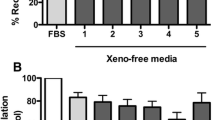Abstract
Background:
Despite major progress in stem cell therapy, our knowledge of the characteristics and tissue regeneration potency of long-term transported cells is insufficient. In a previous in vitro study, we established the optimal cell transport conditions for amniotic fluid stem cells (AFSCs). In the present study, the target tissue regeneration of long-term transported cells was validated in vivo.
Methods:
For renal regeneration, transported AFSCs were seeded on a poly(lactide-co-glycolide) scaffold and implanted in a partially resected kidney. The target tissue regeneration of the transported cells was compared with that of freshly harvested cells in terms of morphological reconstruction, histological microstructure reformation, immune cell infiltration, presence of induced cells, migration into remote organs, expression of inflammation/fibrosis/renal differentiation-related factors, and functional recovery.
Results:
The kidney implanted with transported cells showed recovery of total kidney volume, regeneration of glomerular/renal tubules, low CD4/CD8 infiltration, and no occurrence of cancer during 40 weeks of observation. The AFSCs gradually disappeared and did not migrate into the liver, lung, or spleen. We observed low expression levels of pro-inflammatory cytokines and fibrotic factors; enhanced expression of the genes Wnt4, Pax2, Wt1, and Emx2; and significantly reduced blood urea nitrogen and creatinine values. There were no statistical differences between the performance of freshly harvested cells and that of the transported cells.
Conclusion:
This study demonstrates that long-term transported cells under optimized conditions can be used for cell therapy without adverse effects on stem cell characteristics, in vivo safety, and tissue regeneration potency.







Similar content being viewed by others
References
Henig I, Zuckerman T. Hematopoietic stem cell transplantation-50 years of evolution and future perspectives. Rambam Maimonides Med J. 2014;5:e0028.
Thomas T, Gopikrishna V, Kandaswamy D. Comparative evaluation of maintenance of cell viability of an experimental transport media “coconut water” with Hank’s balanced salt solution and milk, for transportation of an avulsed tooth: an in vitro cell culture study. J Conserv Dent. 2008;11:22–9.
Yu N, Chun SY, Ha Y, Kim HY, Kim DH, Kim J, et al. Optimal stem cell transporting conditions to maintain cell viability and characteristics. Tissue Eng Regen Med 2018. https://doi.org/10.1007/s13770-018-0133-y.
Baraniak PR, McDevitt TC. Stem cell paracrine actions and tissue regeneration. Regen Med. 2010;5:121–43.
Chun SY, Kim HT, Ha YS, Yu NH, Lih E, Kim DH, et al. Initial immunomodulation using Mg(OH)2 promotes renal regeneration via anti-inflammatory processes. J Biomater Tissue Eng. 2018;8:704–15.
Li E, Park KW, Chun SY, Kim H, Kwon TG, Joung YK, et al. Biomimetic porous PLGA scaffolds incorporating decellularized extracellular matrix for kidney tissue regeneration. ACS Appl Mater Interfaces. 2016;8:21145–54.
Perin L, Sedrakyan S, Giuliani S, Da Sacco S, Carraro G, Shiri L, et al. Protective effect of human amniotic fluid stem cells in an immunodeficient mouse model of acute tubular necrosis. PLoS One. 2010;5:e9357.
Joo S, Ko IK, Atala A, Yoo JJ, Lee SJ. Amniotic fluid-derived stem cells in regenerative medicine research. Arch Pharm Res. 2012;35:271–80.
Imberti B, Morigi M, Tomasoni S, Rota C, Corna D, Longaretti L, et al. Insulin-like growth factor-1 sustains stem cell-mediated renal repair. J Am Soc Nephrol. 2007;18:2921–8.
Waxman AB, Kolliputi N. IL-6 protects against hyperoxia-induced mitochondrial damage via Bcl-2–induced Bak interactions with mitofusions. Am J Respir Cell Mol Biol. 2009;41:385–96.
Sung HJ, Meredith C, Johnson C, Galis ZS. The effect of scaffold degradation rate on three-dimensional cell growth and angiogenesis. Biomaterials. 2004;25:5735–42.
Kyurkchiev D, Bochev I, Ivanova-Todorova E, Mourdjeva M, Oreshkova T, Belemezova K, et al. Secretion of immunoregulatory cytokines by mesenchymal stem cells. World J Stem Cells. 2014;6:552–70.
Kim BS, Chun SY, Lee JK, Lim HJ, Bae JS, Chung HY, et al. Human amniotic fluid stem cell injection therapy for urethral sphincter regeneration in an animal model. BMC Med. 2012;10:94.
Guest DJ, Smith MR, Allen WR. Equine embryonic stem-like cells and mesenchymal stromal cells have different survival rates and migration patterns following their injection into damaged superficial digital flexor tendon. Equine Vet J. 2010;42:636–42.
Barbash IM, Chouraqui P, Baron J, Feinberg MS, Etzion S, Tessone A, et al. Systemic delivery of bone marrow–derived mesenchymal stem cells to the infarcted myocardium. Circulation. 2003;108:863–8.
Kurtz A. Mesenchymal stem cell delivery routes and fate. Int J Stem Cells. 2008;1:1–7.
Aguilar S, Nye E, Chan J, Loebinger M, Spencer-Dene B, Fisk N, et al. Murine but not human mesenchymal stem cells generate osteosarcoma-like lesions in the lung. Stem Cells. 2007;25:1586–94.
Ankrum JA, Ong JF, Karp JM. Mesenchymal stem cells: immune evasive, not immune privileged. Nat Biotechnol. 2014;32:252–60.
Rodrigues WF, Miguel CB, Napimoga MH, Oliveira CJ, Lazo-Chica JE. Establishing standards for studying renal function in mice through measurements of body size-adjusted creatinine and urea levels. Biomed Res Int 2014;2014:872827.
Acknowledgements
This research was supported by the Basic Science Research Program through the National Research Foundation of Korea (NRF) & funded by the Korean government (MSIT) (2014M3A9D3034164), (2015R1C1A1A01053509) (2016R1C1B1011180) (2018R1C1B5040264), and the Ministry of Trade, Industry and Energy (R0005886).
Author information
Authors and Affiliations
Corresponding authors
Ethics declarations
Conflicts of interest
The authors declare that they have no conflict of interest.
Ethical statement
This study was approved by the Ethics Committee of Kyungpook National University School of Medicine and all in vivo experimental protocols were approved by the Yeungnam University Institutional Animal Care and Use Committee (YUMC-AEC2015-003).
Rights and permissions
About this article
Cite this article
Yu, Nh., Chun, S.Y., Ha, YS. et al. In Vivo Safety and Regeneration of Long-Term Transported Amniotic Fluid Stem Cells for Renal Regeneration. Tissue Eng Regen Med 16, 81–92 (2019). https://doi.org/10.1007/s13770-018-0162-6
Received:
Revised:
Accepted:
Published:
Issue Date:
DOI: https://doi.org/10.1007/s13770-018-0162-6



